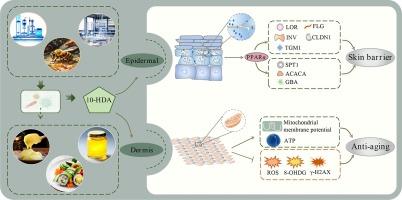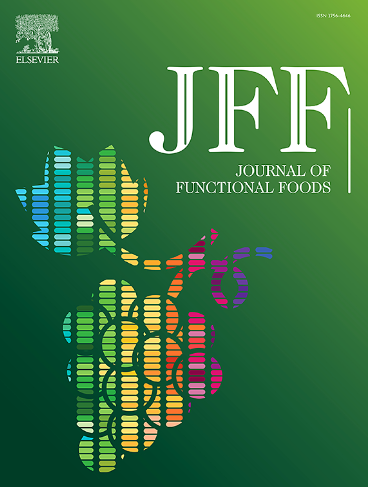Biologically synthesized 10-Hydroxy-2-Decenoic acid activates cornified envelope formation via PPARα signaling, and regulates oxidative respiratory chain to improve mitochondrial function
IF 3.8
2区 农林科学
Q2 FOOD SCIENCE & TECHNOLOGY
引用次数: 0
Abstract
10-Hydroxy-2-decenoic acid is a trans-unsaturated fatty acid exclusively found in royal jelly, known for its health and medical benefits. The current isolation and preparation methods have limitations such as low yield, high costs, difficult operation, and mixed products, which hinder its wider application. This study introduced P450 enzyme fusion gene into S. cerevisiae BY4741, then fermenting trans-2-decenoic acid could produce 10-Hydroxy-2-decenoic acid. With the biosynthesized 10-Hydroxy-2-decenoic acid, we explored its potential application in skin care. Transcriptomic results suggested that 10-Hydroxy-2-decenoic acid promoted epidermal barrier function and dermal energy metabolism. In vitro experiments revealed that within the epidermal layer, 10-Hydroxy-2-decenoic acid activated PPARα signaling and enhanced the expression of downstream genes IVL, LOR, FLG, and TGM1, thereby promoting epidermal differentiation. It upregulated the expression of SPT, GBA, and ACACA, increasing intercellular lipid content and accelerating the formation of the cornified envelope. In the dermal layer, 10-HDA is capable of enhancing the mitochondrial membrane potential, reinforcing the proton gradient, thereby increasing the efficiency of the coupled electron transport chain and leading to the generation of more ATP. It also upregulates NADPH, providing a certain level of reductive power to reduce the production of oxidative by-products, improving mitochondrial functional efficiency. Taken together, these findings indicated that in addition to its application in food and health products, biologically synthesized 10-Hydroxy-2-decenoic acid could serve as an effective skincare ingredient, contributing to skin barrier repair and resistance against skin aging. However, the deeper mechanism by which 10-HDA functions still needs to be further explored.

生物合成的 10-羟基-2-癸烯酸通过 PPARα 信号激活粟粒状包膜的形成,并调节氧化呼吸链以改善线粒体功能
10-羟基-2-癸烯酸是蜂王浆中独有的一种反式不饱和脂肪酸,因其对健康和医疗的益处而闻名。目前的分离和制备方法存在产量低、成本高、操作难度大、产品混杂等局限性,阻碍了其广泛应用。本研究将 P450 酶融合基因引入 S. cerevisiae BY4741,然后发酵反式-2-癸烯酸可产生 10-羟基-2-癸烯酸。利用生物合成的 10-羟基-2-癸烯酸,我们探索了其在皮肤护理方面的潜在应用。转录组结果表明,10-羟基-2-癸烯酸能促进表皮屏障功能和真皮能量代谢。体外实验显示,在表皮层内,10-羟基-2-癸烯酸能激活 PPARα 信号传导,增强下游基因 IVL、LOR、FLG 和 TGM1 的表达,从而促进表皮分化。它能上调 SPT、GBA 和 ACACA 的表达,增加细胞间脂质含量,加速粟粒状包膜的形成。在真皮层,10-HDA 能增强线粒体膜电位,加强质子梯度,从而提高耦合电子传递链的效率,产生更多的 ATP。它还能上调 NADPH,提供一定的还原力,减少氧化副产物的产生,提高线粒体的功能效率。综上所述,这些研究结果表明,生物合成的 10-羟基-2-癸烯酸除了可用于食品和保健品外,还可作为一种有效的护肤成分,促进皮肤屏障的修复,抵抗皮肤老化。然而,10-羟基-2-癸烯酸发挥作用的深层机制仍有待进一步探索。
本文章由计算机程序翻译,如有差异,请以英文原文为准。
求助全文
约1分钟内获得全文
求助全文
来源期刊

Journal of Functional Foods
FOOD SCIENCE & TECHNOLOGY-
CiteScore
9.60
自引率
1.80%
发文量
428
审稿时长
76 days
期刊介绍:
Journal of Functional Foods continues with the same aims and scope, editorial team, submission system and rigorous peer review. We give authors the possibility to publish their top-quality papers in a well-established leading journal in the food and nutrition fields. The Journal will keep its rigorous criteria to screen high impact research addressing relevant scientific topics and performed by sound methodologies.
The Journal of Functional Foods aims to bring together the results of fundamental and applied research into healthy foods and biologically active food ingredients.
The Journal is centered in the specific area at the boundaries among food technology, nutrition and health welcoming papers having a good interdisciplinary approach. The Journal will cover the fields of plant bioactives; dietary fibre, probiotics; functional lipids; bioactive peptides; vitamins, minerals and botanicals and other dietary supplements. Nutritional and technological aspects related to the development of functional foods and beverages are of core interest to the journal. Experimental works dealing with food digestion, bioavailability of food bioactives and on the mechanisms by which foods and their components are able to modulate physiological parameters connected with disease prevention are of particular interest as well as those dealing with personalized nutrition and nutritional needs in pathological subjects.
 求助内容:
求助内容: 应助结果提醒方式:
应助结果提醒方式:


